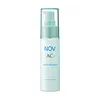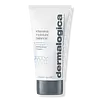What's inside
What's inside
 Key Ingredients
Key Ingredients

 Benefits
Benefits

 Concerns
Concerns

 Ingredients Side-by-side
Ingredients Side-by-side

Water
Skin ConditioningButylene Glycol
HumectantSqualane
EmollientBetaine
HumectantDiglycerin
HumectantPentaerythrityl Tetraethylhexanoate
EmollientGlyceryl Stearate Se
EmulsifyingBatyl Alcohol
EmollientPetrolatum
EmollientHydrogenated Palm Oil
EmollientStearic Acid
CleansingBehenyl Alcohol
EmollientDimethicone
EmollientCholesteryl Hydroxystearate
EmollientCarbomer
Emulsion StabilisingTocopherol
AntioxidantStearyl Glycyrrhetinate
Skin ConditioningHydroxyethylcellulose
Emulsion StabilisingSodium Hydroxide
BufferingPotassium Ascorbyl Tocopheryl Phosphate
AntioxidantRaffinose
Skin ConditioningCeramide NP
Skin ConditioningGlycolic Acid
BufferingSodium Hyaluronate
HumectantPolyquaternium-51
Skin ConditioningRetinyl Palmitate
Skin ConditioningZea Mays Oil
EmulsifyingRiboflavin
Cosmetic ColorantMethylparaben
PreservativeWater, Butylene Glycol, Squalane, Betaine, Diglycerin, Pentaerythrityl Tetraethylhexanoate, Glyceryl Stearate Se, Batyl Alcohol, Petrolatum, Hydrogenated Palm Oil, Stearic Acid, Behenyl Alcohol, Dimethicone, Cholesteryl Hydroxystearate, Carbomer, Tocopherol, Stearyl Glycyrrhetinate, Hydroxyethylcellulose, Sodium Hydroxide, Potassium Ascorbyl Tocopheryl Phosphate, Raffinose, Ceramide NP, Glycolic Acid, Sodium Hyaluronate, Polyquaternium-51, Retinyl Palmitate, Zea Mays Oil, Riboflavin, Methylparaben
Water
Skin ConditioningEthylhexyl Hydroxystearate
EmollientButylene Glycol
HumectantCetearyl Ethylhexanoate
EmollientCetyl Caprylate
EmollientStearic Acid
CleansingPEG-8
HumectantOctyldodecanol
EmollientDimethicone
EmollientGlyceryl Stearate Se
EmulsifyingPEG-100 Stearate
Sodium Hyaluronate
HumectantHydrolyzed Sodium Hyaluronate
Skin ConditioningSodium Ascorbyl Phosphate
AntioxidantChlorella Vulgaris Extract
Skin ConditioningCeramide NP
Skin ConditioningPhytosterols
Skin ConditioningCentella Asiatica Extract
CleansingLinoleic Acid
CleansingEchinacea Purpurea Extract
MoisturisingAloe Barbadensis Extract
Skin ConditioningPalmitic Acid
EmollientMyristic Acid
CleansingRosa Centifolia Extract
Skin ConditioningLactic Acid
BufferingLinolenic Acid
CleansingPropanediol
SolventTocopherol
AntioxidantPotassium Cetyl Phosphate
EmulsifyingHelianthus Annuus Seed Oil
EmollientTetrasodium Glutamate Diacetate
Ethylhexylglycerin
Skin ConditioningCetyl Alcohol
EmollientCarbomer
Emulsion StabilisingHydroxystearic Acid
CleansingAminomethyl Propanol
BufferingSodium Hydroxide
BufferingPhenoxyethanol
PreservativeWater, Ethylhexyl Hydroxystearate, Butylene Glycol, Cetearyl Ethylhexanoate, Cetyl Caprylate, Stearic Acid, PEG-8, Octyldodecanol, Dimethicone, Glyceryl Stearate Se, PEG-100 Stearate, Sodium Hyaluronate, Hydrolyzed Sodium Hyaluronate, Sodium Ascorbyl Phosphate, Chlorella Vulgaris Extract, Ceramide NP, Phytosterols, Centella Asiatica Extract, Linoleic Acid, Echinacea Purpurea Extract, Aloe Barbadensis Extract, Palmitic Acid, Myristic Acid, Rosa Centifolia Extract, Lactic Acid, Linolenic Acid, Propanediol, Tocopherol, Potassium Cetyl Phosphate, Helianthus Annuus Seed Oil, Tetrasodium Glutamate Diacetate, Ethylhexylglycerin, Cetyl Alcohol, Carbomer, Hydroxystearic Acid, Aminomethyl Propanol, Sodium Hydroxide, Phenoxyethanol
 Reviews
Reviews

Ingredients Explained
These ingredients are found in both products.
Ingredients higher up in an ingredient list are typically present in a larger amount.
Butylene Glycol (or BG) is used within cosmetic products for a few different reasons:
Overall, Butylene Glycol is a safe and well-rounded ingredient that works well with other ingredients.
Though this ingredient works well with most skin types, some people with sensitive skin may experience a reaction such as allergic rashes, closed comedones, or itchiness.
Learn more about Butylene GlycolCarbomer is a polymer of acrylic acid. Its main role is to create a gel consistency.
A high amount of carbomer can cause pilling or balling up of products. Don't worry, most products contain 1% or less of carbomer.
Ceramide NP is a type of ceramide and formally known as ceramide 3.
Ceramides are intercellular lipids naturally found in our skin that bonds dead skin cells together to create a barrier. They are known for their ability to hold water and thus are a great ingredient for dry skin.
Ceramides are an important building block for our skin barrier. A stronger barrier helps the skin look more firm and hydrated. By bolstering the skin ceramides act as a barrier against irritating ingredients. This can help with inflammation as well.
If you would like to eat ceramides, sweet potatoes contain a small amount.
Read more about other common types of ceramides here:
Ceramide AP
Ceramide EOP
Dimethicone is a type of synthetic silicone created from natural materials such as quartz.
What it does:
Dimethicone comes in different viscosities:
Depending on the viscosity, dimethicone has different properties.
Ingredients lists don't always show which type is used, so we recommend reaching out to the brand if you have questions about the viscosity.
This ingredient is unlikely to cause irritation because it does not get absorbed into skin. However, people with silicone allergies should be careful about using this ingredient.
Note: Dimethicone may contribute to pilling. This is because it is not oil or water soluble, so pilling may occur when layered with products. When mixed with heavy oils in a formula, the outcome is also quite greasy.
Learn more about DimethiconeGlyceryl Stearate Se is a self-emulsifying (SE) form of glyceryl stearate. Self-emusifying means this ingredient automatically blends with water. It is an emulsifier, emollient, and cleansing agent.
As an emulsifier, Glyceryl Stearate Se prevents ingredients such as oil and water from separating. It is also a surfactant, meaning it helps cleanse the skin. Surfactants help gather oil, dirt, and other pollutants so they may be rinsed away easily.
Emollients help your skin stay smooth and soft. It does so by creating a film on top of the skin that helps trap moisture in.
Learn more about Glyceryl Stearate SeSodium Hyaluronate is hyaluronic acid's salt form. It is commonly derived from the sodium salt of hyaluronic acid.
Like hyaluronic acid, it is great at holding water and acts as a humectant. This makes it a great skin hydrating ingredient.
Sodium Hyaluronate is naturally occurring in our bodies and is mostly found in eye fluid and joints.
These are some other common types of Hyaluronic Acid:
Learn more about Sodium HyaluronateSodium Hydroxide is also known as lye or caustic soda. It is used to adjust the pH of products; many ingredients require a specific pH to be effective.
In small amounts, sodium hydroxide is considered safe to use. However, large amounts may cause chemical burns due to its high alkaline.
Your skin has a natural pH and acid mantle. This acid mantle helps prevent harmful bacteria from breaking through. The acid mantle also helps keep your skin hydrated.
"Alkaline" refers to a high pH level. A low pH level would be considered acidic.
Learn more about Sodium HydroxideStearic Acid is a fatty acid. It is an emollient, emulsifier, and texture enhancer.
As an emollient, stearic acid helps soften skin. It aids the skin's protective barrier by preventing water loss. It also provides a gentle cleansing effect without stripping away natural oils.
Stearic acid may also be used to enhance the texture of products. It can add volume and stabilize ingredients such as water and oil. This can help water and oil ingredients from separating.
Sources of stearic acid include animal or vegetable fats/oils such as coconut or shea. It can be naturally found in butter, cocoa butter, shea butter, vegetable fats, and animal tallow.
This ingredient may not be Malassezia folliculitis, or fungal-acne safe.
Learn more about Stearic AcidTocopherol (also known as Vitamin E) is a common antioxidant used to help protect the skin from free-radicals and strengthen the skin barrier. It's also fat soluble - this means our skin is great at absorbing it.
Vitamin E also helps keep your natural skin lipids healthy. Your lipid skin barrier naturally consists of lipids, ceramides, and fatty acids. Vitamin E offers extra protection for your skin’s lipid barrier, keeping your skin healthy and nourished.
Another benefit is a bit of UV protection. Vitamin E helps reduce the damage caused by UVB rays. (It should not replace your sunscreen). Combining it with Vitamin C can decrease sunburned cells and hyperpigmentation after UV exposure.
You might have noticed Vitamin E + C often paired together. This is because it is great at stabilizing Vitamin C. Using the two together helps increase the effectiveness of both ingredients.
There are often claims that Vitamin E can reduce/prevent scarring, but these claims haven't been confirmed by scientific research.
Learn more about TocopherolWater. It's the most common cosmetic ingredient of all. You'll usually see it at the top of ingredient lists, meaning that it makes up the largest part of the product.
So why is it so popular? Water most often acts as a solvent - this means that it helps dissolve other ingredients into the formulation.
You'll also recognize water as that liquid we all need to stay alive. If you see this, drink a glass of water. Stay hydrated!
Learn more about Water